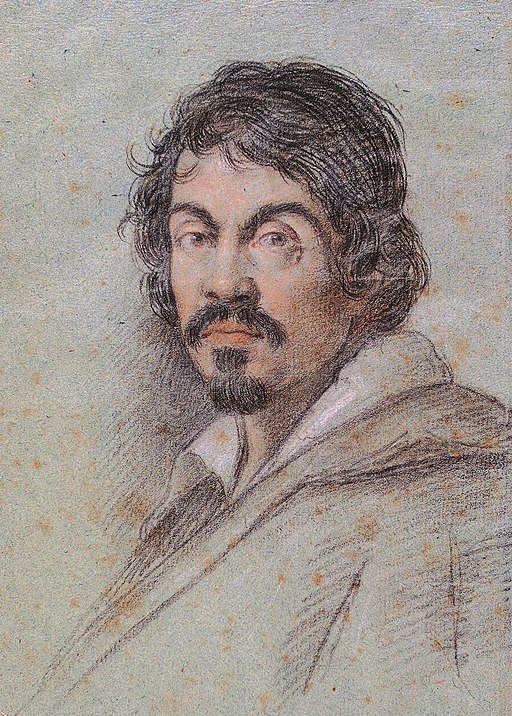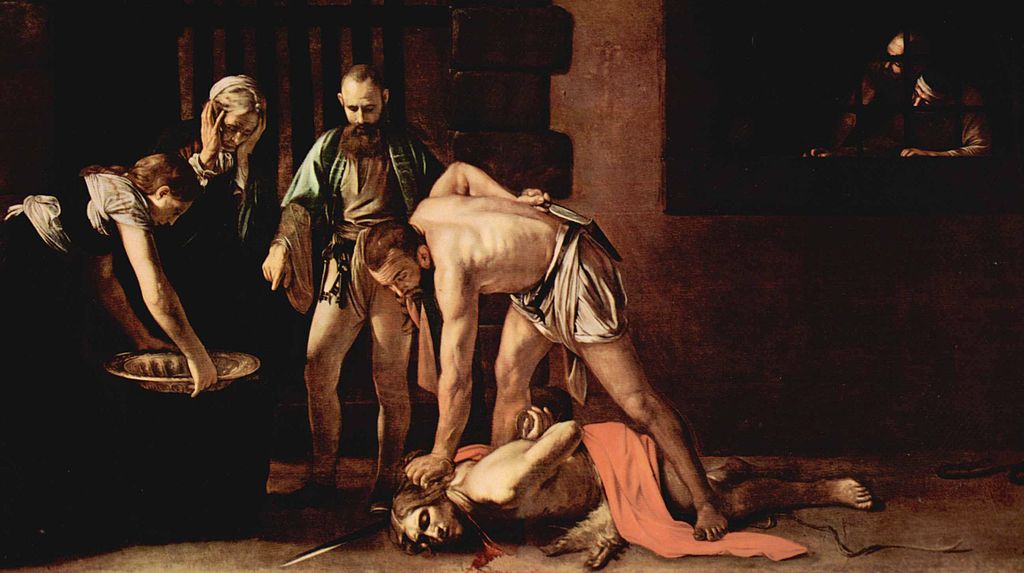Caravaggio
Biblical or historical, crime has always irrigated art with its dramatic power. Until, sometimes, prosecuting artists in real life! Take a look back at the violent adventures of Caravaggio (1571-1610), master of bloody scenes in Chiaroscuro, who himself was guilty of homicide…
Main subject of his theatrical works depicting characters with their throats cut or stabbed on a dark background, crime was also part of Caravaggio’s life, punctuated by real blade blows… A sharp journey that begins as soon as he arrives in Rome. Michelangelo Merisi da Caravaggio was then about 18 years old and lived modestly. But his talent quickly secures him protectors and powerful clients like Cardinal Francesco Maria del Monte or his neighbour, the Genoese marquis and banker Vincenzo Giustiniani. Perhaps intoxicated by this dazzling success, and already proud by nature, Caravaggio quickly forged a reputation as a fiery, touchy and feisty man. A cocktail all the more explosive as the painter assiduously frequents taverns and has taken to wielding a sword like members of the former nobility, quick to draw to defend their honor…
Serial violence
Often involved in brawls or fights, Caravaggio ended up in court at least eleven times and several times in prison, from which he got out thanks to his connections. The court records paint a piquant portrait of him. On November 19, 1600, a man lodged a complaint against the 29-year-old artist. Pattern ? Blows and wounds with stick and sword! In 1601, he injured a guard at Castel Sant’Angelo. On August 28, 1603, a rival painter, Giovanni Baglione (who would write his biography in 1642) sued him for defamation, Caravaggio having written and distributed crude poems about him, full of carabineer insults! This earned him imprisonment, which was ultimately shortened following the intervention of the French ambassador.
More incongruously, on April 24, 1604, an inn waiter reproaches him for having thrown a plate of hot artichokes at his face! A few months later, the painter was imprisoned for insulting the urban militia, then arrested on May 28, 1605 for carrying an illegal weapon. In July 1605, he was accused by a notary of having wounded him in the head with a sword. In question?? The honor of the beautiful Lena Antognetti, a courtesan who posed for Caravaggio on several occasions, and whom her interlocutor contemptuously described as a prostitute, adding that she was on the sidewalk in Piazza Navona! The case is serious: the repeat offender takes refuge in Genoa for two months, until the complaint is withdrawn.
Jealousy
As soon as he returned to Rome, his landlady accused him of having torn down his shutters with stones. Exasperated, she had just kicked him out for six months of unpaid rent, and for having holes in his ceiling for artistic lighting! But the escapades of Caravaggio do not stop there. Among other things, the American art historian Felix Witting reports that he would have, “out of jealousy”, “seriously threatened the painter Guido Reni”, and even (it is said in various old works), “sent a Sicilian contract killer to wound the painter Niccolò Pomarancio in the face”, who had succeeded in obtaining the commission for a large fresco!
Quarrels
On May 28, 1606, things got tough. While the whole city is celebrating the coronation of Pope Paul V, Caravaggio, accompanied by friends, quarrels in the middle of the street with a young nobleman with a sulphurous reputation, Ranuccio Tomassoni… and kills him. The conflict having degenerated into a four against four duel, the painter would have fatally pierced his thigh. According to some, the dispute was about a prostitute named Fillide. For Baglione, it is a game of tennis – a match debt of 10 écus, specifies in 1672 another biographer, Giovanni Bellori. In summary, a trifle!
Wounded
Himself wounded, Caravaggio leaves Rome in disaster. Sentenced to death in absentia by the pope, the artist is on the run. Haunted by this tragedy, the paintings he paints in his flight seem darker than ever. In Naples, he made a macabre self-portrait, taking himself as a model to represent the severed head of Goliath. Hunted by the pope’s agents, he continued his flight to Malta, where he painted another surprising painting, The Beheading of Saint John the Baptist, which strangely evokes his Roman affair. The religious scene represented takes on the appearance of a sordid news item: in the courtyard of a prison, Saint John the Baptist, wounded in the throat by a sword which lies not far away, is held down by his assassin who going to finish him off with a dagger. Another chilling detail: the painter inscribes his signature in red letters with the blood flowing from the victim’s throat…

Chalk portrait of Caravaggio by Ottavio Leoni, circa 1621. Photo credit: Artist: Ottavio Leoni, Public domain, via Wikimedia Commons. Source/Photographer: milano.it
Caravaggio caught up by his past
In December 1608, Caravaggio was imprisoned in Fort Saint-Ange in Malta. The knights of the Order, which he had just joined before being brutally removed from it, would he have discovered his criminal past? The painter would then have escaped by climbing the walls of the prison at night to take refuge in Sicily, then again in Naples in 1609, where he would have been the victim of an attempted murder.
In 1610, Caravaggio attempted to return to Rome where the pope was preparing to sign his pardon. But, after having missed his boat, the painter becomes unwell in the small Italian port of Porto Ercole. In the grip of delirium and a high fever, he was transported to a nearby hospital and succumbed on July 18, at the age of 38. Sunstroke, malaria, murder, lead poisoning contained in his paint… Many hypotheses have been put forward on the cause of his death. Until his skeleton was finally exhumed in 2010 from the old hospital cemetery – various scientific analyzes and DNA comparisons carried out by professors Michel Drancourt and the now famous Didier Raoult having made it possible to identify him in 2018 … and to conclude that the painter would have died as a result of staphylococcus aureus septicemia. Consequence of a bone infection, itself due to a leg injury that occurred a few days earlier, during a fight in Naples!

Title: The beheading of St. John the Baptist. Collection:
St. John’s Co-Cathedral. Photo credit: Artist: Caravaggio, Public domain, via Wikimedia Commons
Why so much hate?
It is hardly surprising that violence occupies such an important place in the work of Caravaggio. Some specialists also agree that it is only a simple reflection of the artist’s time.
Government-sanctioned killings, hangings, beheadings, quarterings, and beatings were commonplace in 17th-century Rome.
Nevertheless, it is still strange that decapitation is one of the painter’s recurring themes. No less than 12 of his paintings represent people who have been beheaded or are about to be.
With such a particularity, specialists versed in psychology were able to have a field day and most of them took Freud’s equation as their starting point: decapitation = castration.
However, in the field of Alchemy (a discipline that Caravaggio studied), beheading symbolizes the separation of the Soul from the material world.
Therefore, the artist may be expressing a sense of alienation and a search for a certain integrity.
Mystery…
Today, the painter Caravaggio is as much appreciated for his striking realism and his emotional depth, as for having had an existence worthy of a true Gansta with Baroque sauce.
Sources: PinterPandai, Britannica, National Gallery, Biography
Main photo credit: Artist: Caravaggio (1571–1610). Author: Architas (CC BY-SA 4.0). Collection: Galleria Nazionale d’Arte Antica. Title: Italian: Giuditta e Oloferne / Judith Beheading Holofernes.
Main photo description: the realism and violence of this scene are a revolution in 17th century painting. Here is Judith beheading Holofernes by the Italian genius Caravaggio. This canvas takes up a particularly violent episode from the Old Testament: Judith, a young heroine, to save her people, beheads the tyrant Holofernes, surprised in his sleep.



